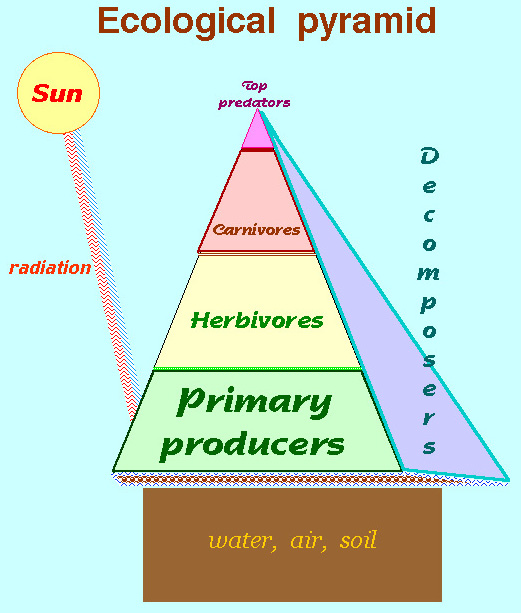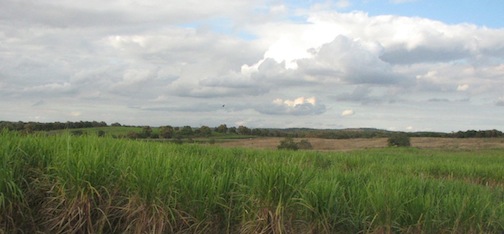The Cuban sugar cane fields against a countryside where two different agricultural practices converged.
Organize
Lists | Three ways to arrange & order | Revolutionary | Question | Evidence | Summary
Add to your list of what were the leading impacts of the Columbian exchange.
| Factors in Columbian exchange: | Evidence for what these mean |
|---|---|
Compare that list to an ecologically coherent listing, such as
| Terms | |||
|---|---|---|---|
| Ecological Factors | |||
| health | |||
| Cycle of relations | population |  |
surroundings |
| food | |||
| land pyramid |  |
||
| ingredients | nutrients | land | water |
Compare and contrast verbally and in writing.
The List of the effects of the Columbian exchange by:
- compare; comparing to the approach of Land, Labor and Wealth
- contrast; contrasting America with Crosby's lands of the "demographic takeover."
Pull the two lists together by first drawing lines to connect between related items.
"The demographic effects of the Columbian exchange are awesome." (p. 24) >-----------------------------> equestrian cultures on the American grasslands (p. 25).
Secondly, with respect to a common element that touches more items on the list than any other concept, circle the top two or three concepts that link to most, or all the others.
Lists | Three ways to arrange & order | Revolutionary | Question | Evidence | Summary
![]()
 Three Ways to organize the ideas:
Three Ways to organize the ideas:
etymologically by the origins of key words | chronologically by when | ecologically by how functions are related.
ETYMOLOGY the Antilles, named for a paradise, discovered as a densely populated place of wildly exotic and impressive people with food enough to sustain millions, gold enough for ornaments, and a written language, with sophisticated math and astronomy among the Mayans.
HISTORY. Chronological
Mayans had a 3000 year heritage 2600 BCE – 250 AD, from the Yucatan to Guatemala and again 300 CE - 900 CE.
1517 pushed back a Spanish invasion of Yucatan.
Olmec in coastal Mexico 1500 BCE
ECOLOGY. Hispaniola, called Ayiti in Taino, The Spanish Isle.
1493, Spanish settle at Navidad, with domesticated animals & plants
1499 rebellion & redefinition of encomiendas
1518, smallpox outbreak
1520, rapid declines in population of the Tainos
1500s drew twice the number of slaves as all of North AmericaMore dates
Lists | Three ways to arrange & order | Revolutionary | Question | Evidence | Summary
![]()
What are we about do do?
Summarize the revolutionary character of the Columbian Exchange.
This thinking – analogical analysis – means breaking things down into comparable concepts that make up a bigger whole. This process of analysis is after all what serious thinking is all about. The outcome is the practice and improvement of a critical capacity to distinguish errors from verity.
 Question?
Question?
How wrong have we been about the Caribbean & Mesoamerica's importance in history?
How is it critical:
We fail to accurately attribute the correct causes to European and American growth, and errors mislead current policies.
What to know:
The food enabled a population explosion, while disease precipitated such a collapse in native populations that the necessity for labor precipitated slavery, a system that so enriched investors as to create a commercial revolution in Europe. Commerce based on gold, silver, sugar, tobacco, hides & tallow, and human labor added great wealth to western European nations, banks and joint stock companies.
How does this relate to CORE? Step Two is Organize, how to put a series of related and unrelated concepts into a logical framework based on evidence.
See a page about order and writing
Lists | Three ways to arrange & order | Revolutionary | Question | Evidence | Summary
![]()
Evidence
" . . . a truly spectacular biological success story."
The Columbian Exchange, p. 108.
Columbian Exchange continues because the ecological basis for a social transformation sustained economic growth at levels never before experienced.
Economy
The ecological realities of Española, Yucatan, the Americas before and after Spanish Settlement 1493-1600.
1, Demographically the populations in Central America, the West Indies, and in the world was altered in the amount of people in each region and the ethnic composition of the Americas even to this day.
2, Nutrition, food exchanges between Eurasia, Africa and the Americas altered the balance of population throughout the world cause Eurasians to experience a population explosion.
3, Domesticated and feral animals from Europe so altered the ecology of the lowlands and adjusted ironically well to the uplands that pigs, chickens, sheep, horses and cows thrived in the Americas.
4, Pestilence from pathogens that caused both acute and chronic diseases which were curable and incurable (such as measles, mumps chickenpox and smallpox from domesticated animals) to which the indigenes (Aboriginal Amerindians such as Taino, Arawak, Ciboney, and Carib) had no resistance due to their prolonged biological isolation from Asian & European populations.
5, Commercial markets in Europe benefitted by the influx of Mexican silver, South American gold, mainland and island sugar production, slaves, hides, animal skins (the hide and tallow trade & beaver, otter, and deer skins) and tobacco trade making new commercial fortunes in Europe and landed elites on American plantations, encomiendas, and rancheros.
6, Intellectual exhaustion of Ancient (Aristotle) ideas amid a flood of new geographical and biological discoveries altered the cosmology and ideology of the dominant European nation's whose shared cultural understanding of the natural world changed drastically replacing the authority of Galen, in medicine, Aristotle in biology, and Ptolemy in geography and astronomy with experimental observations in these fields.
7, Ethical confusion: Bartoleme de las Casas, a Spanish colonist to Española, a Dominican priest, founder of a utopian community, and first Bishop of Chiapas, who wrote the Laws of the Indies, died in 1566. He is an example of opposition to the ill treatment of native peoples because he recognized they were people, not animals, possessing divine souls worthy of salvation.
8, The measure & metric of the globe itself was altered from 1420-1522; the earth was suddenly more than it had ever been before.
9, Astronomy would never again be what it had been before 1600. The old earth centered system was replaced by the "solar system," with the Earth as the third planet of six orbiting the sun.
10, Money, Europeans actually had coinage (silver and gold) with which to support currency used to purchase luxuries from China, India and the spice islands of the Eastern Pacific. Wealth disparities disrupted the old medieval order based on horses, land, serfdom, and nobility.
11, The Chinese & Indonesians gained nutritional food supplies, gold, silver, and technological advantages that increased their population and wealth.
12, Slavery and the slave trade created an permanent under class, exacerbated ethnic prejudice, promoted racism based on skin complexion, and enriched the European commercial classes.
13. The ecology of the planet, long dominated by post-Ice Age isolation and some ongoing exchange in Eurasia, became less distinctly different, or more homogenized. This led to a re-population of the "lands of the demographic takeover," by similar kinds of insects, grasses, herbivores, microbes, and people.
September 21, Crosby, The Columbian Exchange. The Revolution, pp. 208-221.
Lists | Three ways to arrange & order | Revolutionary | Question | Evidence | Summary
What did we do?
1) Compared and contrasted an ecological and an economic set of impacts from lists of how the Columbian Exchange was a revolutionary event in world history.
2) Began to assemble our collection of evidence into a coherent statement of logically related ideas.
3) Become better prepared to discover arguments in Crosby that relate to the essay you are writing on the importance of the Columbian Exchange.
Can you make a case that the Columbian exchange is unimportant? Why not?
Start to write (Find an argument in the Crosby readings): Restate and explain what he is contending.
Summary of the Columbian Exchange's importance.
The Columbian Exchange: Biological and Cultural Consequences of 1492, New York: Greenwood Press, 1972.
Crosby's underlying assumptions from Germs Seeds and Animals.
Crosby's ultimate conclusions.
![]()



